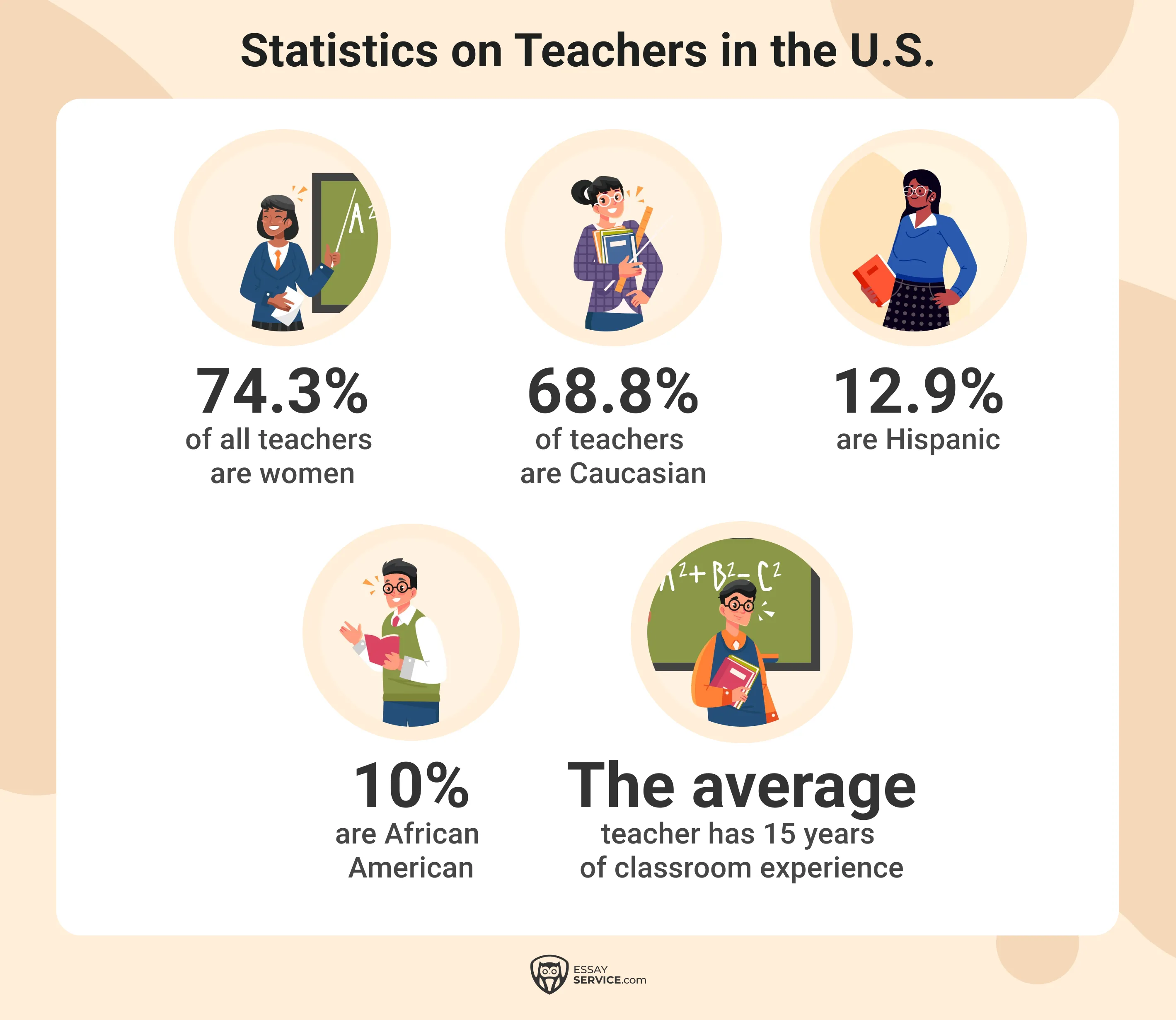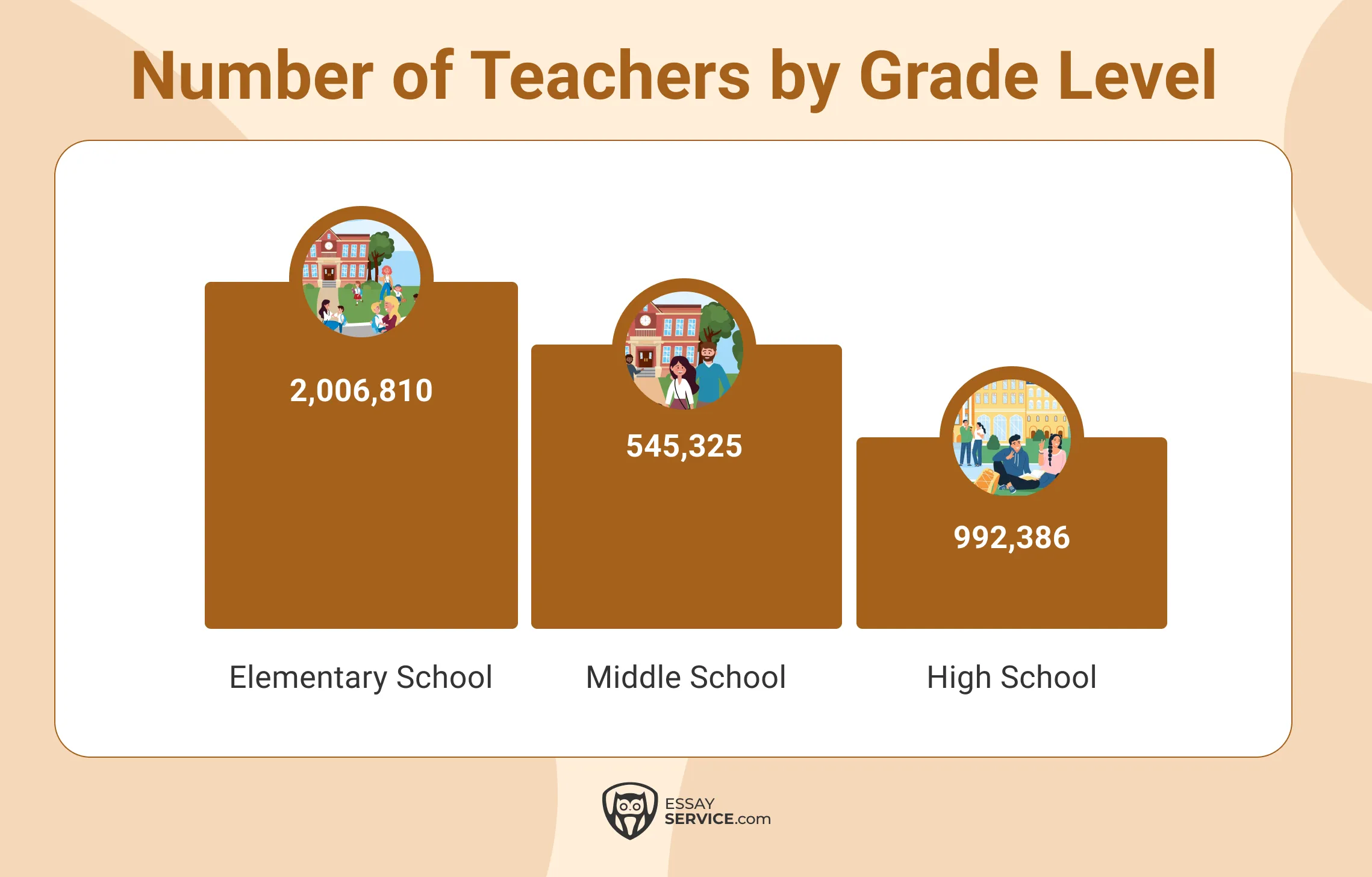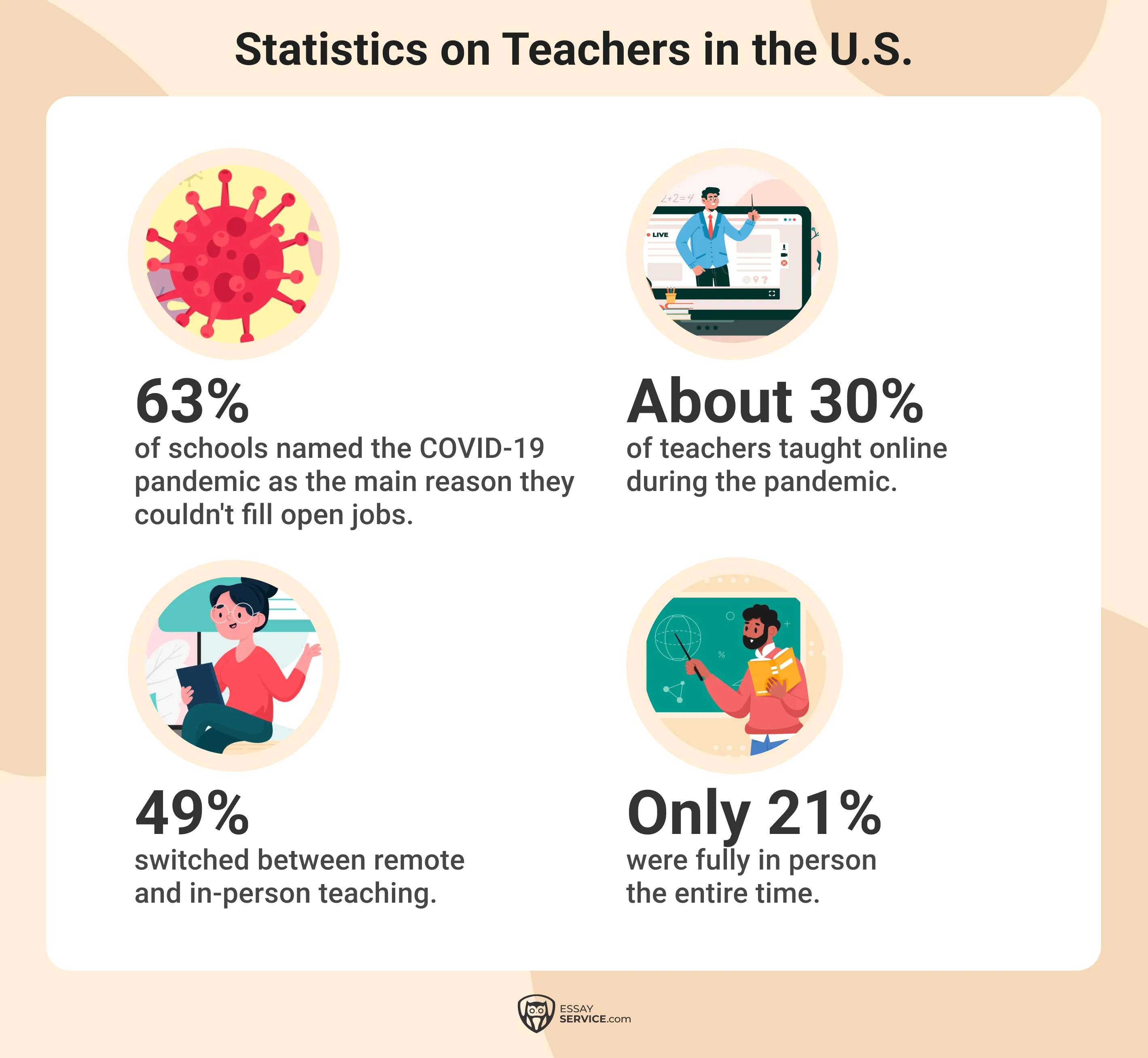There are more than 3.8 million teachers in the U.S. right now. This number seems flashy right away, but it doesn't tell the full story. Most of these are public school teachers, with an average annual salary of $65,090. Many teach five different subjects a day because schools in more than 75% of states are short-staffed. Others focus on just one. What every single educator shares, though, is the responsibility of being there for students, especially when the system doesn't always show up for them.
This article examines the latest data on the number of teachers in the US to understand the implications. If you're researching this information for a school paper and need help finding the right words, EssayService can help. Our platform is a dependable option for students looking for academic help.

How Many Teachers Are There in the U.S.?
Statistics show that the total number of teachers sits at over 3.8 million. That included both full-time and part-time educators across every state and school type. Most of them taught in public schools across all grade levels.
What the Numbers Say About Teachers in the U.S.?
The number of teachers in U.S. by year doesn't swing wildly. You won't see dramatic changes, though some shifts are starting to show, especially in who's entering the classroom and who's deciding to stay. Here's what the current picture looks like:

- Roughly 75% of all teachers are women. That ratio has stayed steady for years.
- The remaining 25% are men. Their numbers are especially low in early education.
- 68.8% of teachers are Caucasian. This still makes up the largest group by a wide margin.
- 12.9% are Hispanic. That number has been rising, but it still depends on the region.
- 10% are African American. These educators have an important role across communities.
- The average teacher has 15 years of classroom experience. That longevity means many teachers have seen entire education trends come and go.
Where Teachers Work: K–12 Grade-Level Breakdown
The total number of teachers in the U.S. includes millions working across every level of K–12 education. But that group isn't evenly spread out. Most teachers work in elementary settings, while fewer are in middle and high schools. The way schools define grade levels can vary a bit across districts, but the national trends are clear.

Elementary School Teachers
Right now, 2,006,810 teachers are working in elementary schools across the country. That's more than half of all U.S. teachers. These roles usually cover kindergarten through fifth grade, though in some districts, elementary school includes sixth grade, and even stretches into the eighth sometimes. No matter how the grade levels are drawn, this group forms the largest portion of the K–12 workforce.
Middle School Teachers
Middle school staffing works a little differently. Schools that run from sixth through eighth grade employ 545,325 teachers. Junior highs, which might include seventh, eighth, and sometimes ninth grade, bring in another 96,160 educators. Taken together, this group makes up roughly 16% of the national teacher count. These grades sit in the middle (literally and developmentally), and the teachers who work here often juggle both academic instruction and emotional turbulence.
High School Teachers
High schools are staffed by 992,386 teachers. That's about 24.7% of all teachers in the country. These educators often cover everything from physics to literature to vocational training. High school teachers' work isn't limited to academics, either. They are also responsible for helping students with college prep and graduation requirements, sometimes all in the same week.
Public vs. Private School Teachers
There are about 3.5 million public school teachers in the United States, which makes up close to 88% of the entire K–12 teaching workforce. Public schools are open to everyone and funded by the government, so the teachers there end up teaching students from all walks of life: different backgrounds, learning styles, and needs.
That means the remaining 12%, about 362,000 teachers, work in private schools. These schools operate outside the public system and often follow different teaching models. Private schools don’t rely on public funding. Instead, they’re supported by tuition paid by families and donations. Because of that, they often have more control over how they design their programs, and what curriculum they follow. A few are highly selective, while many focus on small class sizes or specialized approaches to learning.
Who's Teaching: Demographics of School Teachers
Most teachers in the U.S. are women and most are in their thirties and forties. Pay gaps still exist, especially across gender lines. Let's take a closer look at the amount of teachers in the US and how the exact demographics look like.
Age
Here's how the age breakdown looks across public and private schools in 2026:
Gender
If you've spent time in a classroom, you definitely would have noticed that most teachers are women, especially in early childhood education. The gender gap narrows a bit afterward, but women are still the majority of the workforce. And even in a field dominated by women, the pay gap somehow hasn't gone away.
- Nearly all preschool and kindergarten teachers (97.3%) are women.
- Women make up 74.3% of all teachers in the U.S., while men hold 25.7%.
- Female teachers earn about 95 cents for every dollar paid to men. That's roughly $53,011 for women and about $55,902 for men doing the same work.
Race
Even though slow changes are appearing, the racial makeup of the teaching workforce still leans heavily in one direction. Here's a look at the numbers:
How COVID-19 Changed the Teaching Profession
The pandemic pushed schools and teachers into survival mode. Many classrooms lost staff altogether. Some scrambled to somehow cover absences. Even almost five years later, the ripple effects are hard to ignore.

- Around 63% of public schools with open jobs said the pandemic was mostly why they couldn't fill the spots. That goes for both teachers and support staff.
- By January 2022, almost half of all public schools had at least one vacant teaching position.
- 97% of schools said they sent students home because someone in class had tested positive for COVID.
- About 30% of teachers taught mostly online throughout the pandemic year. 49% split their time between remote and in-person teaching. Only 21% were fully in person the entire time.
- A survey from early 2021 found that nearly one in four teachers planned to leave before the school year ended.
- In March 2020, 24% of teachers said they were likely to leave their state or the profession within five years. A year later, that number had grown to 30%.
Teachers Shortages and Vacancies
The hard truth is that fewer people are entering the teaching profession and more are walking away. As a result, schools struggle to fill in vacancies. Here's what the numbers show:
- Over 75% of states experience teacher shortages.
- 45% of public schools have at least one unfilled teaching position.
- In 2026, the demand for teachers is expected to exceed supply by more than 100,000.
- Nearly 90% of public school districts say they've had a hard time hiring teachers for the current year.
- Low salaries are the most important factor turning away applicants.
- Roles in special education, science, and foreign languages remain some of the hardest to staff.
- In high-poverty districts, 57% of schools are still understaffed.
- In low-poverty areas, 42% of schools have staffing concerns, compared to last year's 52%.
- 45% of public schools reported feeling short on staff, down slightly from 53% the year before.
Job outlooks vary by grade level:
- Preschool teacher employment is expected to grow by 3% through 2032.
- Kindergarten and elementary teaching jobs will likely grow by 1%, which is slower than most other fields.
- Middle school teacher employment is projected to rise by 1%, with around 42,200 openings each year.
- High school teachers' employment is expected to grow by 4% from 2021 to 2031, with about 67,100 job openings per year.
- Special education jobs are expected to stay flat, but there may still be 33,500 openings across grade levels in the coming decade.
A Global Look at Primary School Teachers
The goal of primary education remains the same in every country: give kids a solid start. Given its population and school structures, it only makes sense that the U.S. has more teachers than most countries. You'll see smaller numbers in Europe, although that doesn't translate to fewer resources. It just reflects different approaches to how education is organized. Here's how the numbers compare across a few countries:
Bringing Everything Together
It's easy to talk about millions of teachers like they're just a number, but each one stands in front of real students with real challenges. The data gives us a clear look at the entire educational landscape: who's teaching and what's causing shortages across states. You'll see that some patterns haven't changed in years. Others are changing faster than schools can keep up.
If you're digging into this for a paper and are stuck somewhere between research and a rough draft, EssayService can help you make sense of the numbers. Our professionals can help you turn data and rough ideas into thoughtful papers you'll be proud to submit.
Frequently Asked Questions
How Many High School Teachers in the U.S.?
There are 992,386 high school teachers in the United States, making up about 24.7% of the K–12 teaching workforce.
How Many Public School Teachers in the U.S.?
There are 3,525,397 public school teachers employed across all grade levels.
How Many K–12 Teachers in the U.S.?
In total, there are 4,007,908 K–12 teachers in the U.S.

Jennifer is a student currently pursuing a Journalism major. She oversees the EssayService blog team and uses her journalism skills to ensure all blog posts are accurate, trustworthy, and engaging.
- Parker, A. (2025, March 4). How Many Teachers In The US (2025 Data). Prosperity for All. https://www.prosperityforamerica.org/how-many-teachers-in-the-us/
- Primary education statistics - Statistics Explained. (2025). Europa.eu. https://ec.europa.eu/eurostat/statistics-explained/index.php?title=Primary_education_statistics#Number_of_teachers_and_pupil-teacher_ratios
New posts to your inbox
Your submission has been received!



